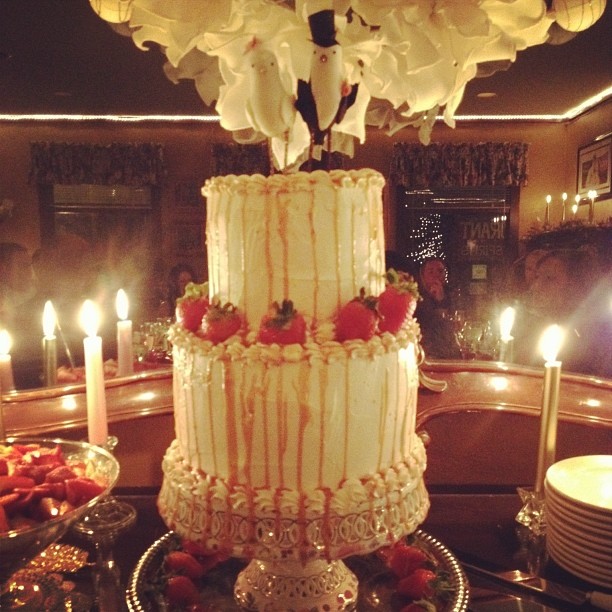 |
| In my Syracuse kitchen. Looking back through my photos, this seems like the best one I have of the kitchen, ironic since it was taken in the reflection of the windows. |
This past week I've been reading "
Alone in the Kitchen with an Eggplant: Confessions of Cooking for One and Dining Alone." Aside from making me hungry, it's also been making me think about eating and cooking for people. So I thought I would write up my own confession of cooking for one and dining alone.
After college I moved to New York City for a year. I was working an office job and living in the Bronx with two roommates I knew from college. I had graduated from college without much of an idea of how to feed myself, and this was not a conducive situation in which to learn. There was at least one disastrous attempt to make Eggplant Parmesan (one of my favorites), but most nights by the time I finally made it home I was too tired to attempt cooking, or I had stayed in Midtown and eaten there with friends. I survived mostly on bagels, cereal,
yogurt and hamburgers at a variety of Midtown diners. At the time it seemed mostly easier and cheaper than attempting my own meals.
But after a year in a job I hated, I left New York City for the colder pastures of Syracuse. I had a room in an apartment I shared with four other graduate students, less money, and way more time. Cheap, plentiful meals could not be found on every block, if I wanted them I was going to need to make them myself. Luckily, during this time I made a friend who knew way more about cooking than I did, and she liked to cook for people. With someone to bounce ideas off of, and to experiment with, I started a trek into the world of cooking. There was a lot to learn, and because the winters in Syracuse are long and dark and deep, there seemed plenty of time to learn it. Over the two years we were in Syracuse at the same time, Kelly and I made more meals and baked goods than I can remember. One time we spent a beautiful fall Saturday picking apples, then made four pies and gave those away.
I made my first jam with strawberries we picked from a u-pick farm in the kitchen of house where she was renting a room for the summer. Even after Kelly left Syracuse, I remained working to finish my thesis and applying to Phd programs.
After finishing my degree at Syracuse, I moved back to Southern Illinois - the place I grew up, and the place my parents still live - to get my doctorate. For a time I lived with my parents, and I took over the cooking. Now our meals also include my boyfriend and one of my brothers, also back at home. The family lets me cook whatever strikes my fancy, and eats it without complaint. I can try larger recipes that I wouldn't have attempted when just cooking for myself. More than that, I love sitting down with everyone at a table full of food. When I lived in Syracuse, I would often spend Sunday out somewhere reading and writing, go grocery shopping around 7, and then cook dinner around 8 or 9. Whatever, I made - often pasta, soup or chili of some kind - would last the week. After eating, I would portion it out into tupperware containers for the week ahead. Though I would sometimes sit down at our small cafe style table, mostly I would just eat standing up in the kitchen. I'm a much more adventurous cook now, in part because of experience, and in part because there are more people around to help me eat the things that I make. Since one pot of food won't last a week, I'm forced to make more meals and move outside my comfort zones. Now, I go to farmer's market on Saturday mornings and buy fruits and veggies for the week. I try to cook seasonally and mostly vegetarian, and I end up stopping by the grocery store on my way home a few nights a week. And in the apartment my boyfriend and I share, we've even thrown some dinner parties, something I never really did in New York because of the table and the roommates. And so, to paraphrase William Carlos Williams, this is just to say I really like not just cooking for myself all the time. All the meals, even the ones that are rushed and thrown together, or that don't really turn out, are better for having a table of people to share them with.
But this is also to say that while reading"Alone in the Kitchen," I began to get nostalgic for my kitchen in Syracuse. There was something joyous in eating whatever I felt like eating, in whatever form that took -
one night I happily made four popovers and ate them still warm with honeyed brown butter. Another favorite was a plate of "egg in a hole,"with ketchup; I remember explaining to one friend that the egg and bread were made more magical after being fried together than alone. Mostly, I think I would be quite content to eat pesto and hot dogs in the summer, and warm soups and grilled cheese through the winter. And I have many such fond memories of cooking and eating simply for myself. But there is a specific fusion of food and time and place - watching
Doctor Who and eating
Red Pepper Pitas with Feta Cheese. I'm not even sure what inspired me to start watching
Doctor Who, aside from Tumblr, probably, but there I was. And of course, it wasn't long til I was head over heels in love with this British show about a time traveling man and his blue box. I must have eaten a lot of meals while watching the first four seasons, but in my memory it's always these Red Pepper Pitas and the episode
"Bad Wolf." I would buy a package of pitas, slice up a red pepper and onion, arrange the veggies on the pita with the cheese, and drizzle it with olive oil, salt and pepper. Into the over they would go for 8 minutes. (Only 8 minutes! Both cheap and fast!) There was a corner of the counter right next to the oven, where I would often set up my laptop, so I could watch television while preparing and eating food. And while it's a solitary sort of joy, I wouldn't trade away the memories of watching
Doctor Who and eating the Red Pepper Pitas right out of the oven while standing in that drafty kitchen.
Last week, fueled by some Proustian nostalgia, I made these Red Pepper Pitas for my parents and my boyfriend - just two, cut in half, as sort of an appetizer. (Because I wasn't just cooking for myself, I also made another pizza with pesto and cheese). Both were delicious, but the Pitas were just how I remembered them, hot and salty and bread-y and crispy.
Red Pepper Pitas with Feta and Red Onion (makes 2 single-serve pitzas)Adapted ever-so-slightly from
NotEatingOutinNY2 pocketless pitas
about 1/2 of a medium red bell pepper, thinly sliced
1/4 medium red onion, thinly sliced (I mostly use yellow onions, because I keep them on hand)
about 3/4 cup feta, crumbled (I've never measured, I just sprinkle till the pita looks full)
2 tsp olive oil
Kosher salt
freshly ground black pepper to taste
Preheat oven to 400 degrees. Begin Episode of Doctor Who. Place pitas on a baking sheet and arrange peppers, onions, and feta on both. Drizzle each with 1 tsp of olive oil. Sprinkle with pepper and a touch of salt. Bake for about 8 minutes. Remove pitas from oven and let cool a moment before serving (or not).













